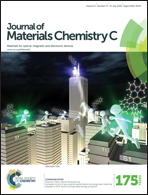A dual-functional upconversion core@shell nanostructure for white-light-emission and temperature sensing†
Abstract
A strategy to simultaneously achieve white-light-emission and temperature sensing via a 980 nm excitable upconversion core@shell nanoarchitecture design was provided. Specifically, the prepared Yb/Ho/Ce: NaGdF4@Yb/Tm: NaYF4 active-core@active-shell nanocrystals enabled the spatially confined doping of Ho3+ in the core and Tm3+ in the shell and thus greatly reduced the adverse energy transfers between them, leading to intense upconversion emissions for both Ho3+ and Tm3+ activators. Notably, introducing Ce3+ into the core resulted in the competition of radiation transitions from the Ho3+: 5S2, 5F4 green-emitting states and Ho3+: 5F5 red-emitting one, which was beneficial to tune the red to green intensity ratio and ultimately realize white-light luminescence. Temperature-dependent upconversion emission spectra of the core@shell samples evidenced the joint contribution of Ce3+ in the core and Tm3+ in the shell to improve sensitivity for temperature detection. As a consequence, the core@shell nanostructure was demonstrated to have a high temperature sensitivity (2.4% K−1) and excellent signal discriminability (3040 cm−1), being potentially applicable as an optical thermometric material.


 Please wait while we load your content...
Please wait while we load your content...